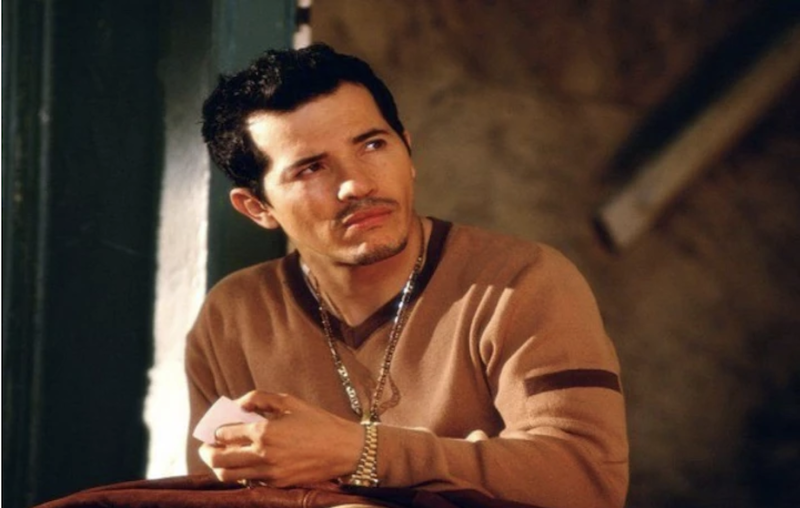“…and with today’s youthful energy, it is not unlikely that a Latin Renaissance can yet take place in Hollywood, whose worldwide influence is bigger than ever, for better or for worse.”
Written by Edwin Pagán in 2002
Those words summed up golden-age screen starlet Dolores Del Rio‘s forward to George Hadley-García’s book, Hispanic Hollywood, in 1979. More than two decades later, they seem more prophetic than the hopeful wishes of a great actress in her twilight years (she died in 1983). Today, in mainstream Hollywood, Latinos are still both under- and misrepresented. There is, however, an emerging crop that is quietly re-establishing the Hispanic presence in movie making, both in front and behind the cameras. Producers like Moctezuma Esparza (The Milagro Beanfield War,Selena), Academy Award-winner David Valdés (The Green Mile, Unforgiven) and Dennis E. Leoni (Resurrection Boulevard), and directors such as Robert Rodríguez (El Mariachi, Spy Kids 1 & 2) and Guillermo Del Toro (Mimic, Blade 2), who are transforming the way the Hollywood studio system views this yet untapped – and often overlooked market.
Is It Soup Yet?
The film Selena, based on the life and tragic death of the Tejano singing sensation of the same name, proved that a Latino-themed movie could capture the hearts of a North American audience. But it was Rodríguez’s “stealthy” Spy Kids, with its $100 million+ box office gross, that proved it could also gain access to its wallet. While Selena showed that a film with a Latina in a lead role (Jennifer López) could successfully be made and distributed in the U.S. mainland/mainstream market, Spy Kids also demonstrated that a film about an adventurous family, that just happened to be Latino, could be a runaway box-office smash.
The current established and emerging Latino filmmaker is fast gaining a foothold in both the Hollywood and independent film arenas. But even before the fuse is completely lit on what is being called as the emergence of the “Latino Film Explosion” on the East Coast, and Cine Revolución (Film Revolution) in the West, a series of national debates are being waged that promise to be, at the very least, high-spirited.
“The term ‘explosion’ bothers me immensely because the connotation is that where there is an explosion, a great silence often follows — that something is lacking after all the noise has subsided,” says Moctezuma Esparza. “What we are actually seeing now is an incremental buildup of Latino talent, writers, producers, directors, actors, agents, in all levels of the business, leading to a critical mass. The real question is ‘will we maintain the development of a sustainable Latino film renaissance and a new aesthetic to guide it in the business of filmmaking?’” The answer, he says: “ABSOLUTELY.”
According to Esparza, whose heavily-promoted HBO biopic, Introducing Dorothy Dandridge, received critical acclaim, the next five to ten years will be a crucial period in what strides Latinos make in the entertainment industry. It will also be a period for us, he contends, to re-invent and modify the past negative perceptions within the industry via the next tier of contributions we make, as well as through the products that we produce. Ever the political activist, he also notes: “We have a responsibility to be ready to perform – ensuring that we can prosper even in the current industry retrenchment. It’s challenging but we have to work to be part of both the formula and the equation.”

Franc.Reyes, whose film Empire was screened at the Sundance American Showcase venue earlier this year, falls on the side that a “Latino film explosion is inevitable. With the success of Spy Kids, Robert Rodríguez has proved that not every Latino movie has to have a taco or rice and beans in it,” he says. “Mr. Rodríguez chose to tell a universal story with Latino characters. This does more for us than Latin actors who think they are helping the community when they take high profile roles playing white or black characters.”
Jumping The Great Dive
But the silver screen isn’t the only place where Latinos remain disproportionately absent. According to the National Association of Hispanic Journalist’sSixth Annual “Network Brownout 2001: The Portrayal of Latinos in Network Television news, 2000”, “Latino stories continue to be seriously underrepresented in television news and their portrayals are often stereotyped and highly divergent from the true essence of Latino society and culture.“
The recent death of legendary Mexican actress, María Félix, 88, illustrated the great disconnect among Latino and Anglo movie-going audiences. While Spanish-language television and print media outlets provided in-depth coverage of Felix’ passing, English media sources in the U.S. barely mentioned it as a footnote. However, a British Broadcasting Corporation headline, while incongruously gauging her contributions to cinema to an American pop icon, nevertheless put her loss into its proper perspective: “Mexico mourns its ‘Marilyn.”
Interviewed in 1999 by Mr. Showbiz online (now part of abcnews.com) in the midst of the so-called Latino pop music explosion, Mexican-born actress Salma Hayek referred to the Latino explosion as “BS.” And added, “I’m doing great, but I can’t sit here and say, ‘Yeah, we’re doing great! Latino power!’ That’s not true. It’s just two of us. If I don’t do it, if Jennifer [López] doesn’t do it, the movie doesn’t get done.” Her remarks pointing to the major studios’ reluctance to greenlight any Latino-themed projects without high profile/cross-over talent in the mix, as well as the lack of working Latino actors in the industry. Hayek has since taken matters into her hands and started her own production company, Ventanarosa, and begun to produce her own projects. Together with Miramax Films, the company will also produce Frida; a movie based on the controversial life of Mexican artist Frida Kahlo.

steps into the shoes of Iconic Mexican artist Frida (2002). (Photo: Warner Bros. Miramax)
The attention that was put on Latin music in 1999, lead by such talents as Ricky Martin, Marc Anthony, Jennifer López, and Enrique Iglesias, clearly caught the English language industry by surprise. When Rolling Stone asked record executives why this crop of artists were sweeping the charts, they could only point to the “surprising success of albums like Cuba’s Buena Vista Social Club with non-Latin record buyers”. Often at a loss as how to best market a Latino product, distributors simply missed the mark and instead marginalized the buying power behind the 30 million Hispanic Americans in the U.S. It should not come a surprise then that Hollywood’s commercial film mill is yet to effectively realize the full potential of this sector, or even how to market it.
This trend may be coming to an end, however, as a new generation of Non-Hispanic and Hispanic audiences looks for intelligent movie material. Similar to the energy that inspired the French New Wave of the 1950s and 60s, Amores Perros, directed by Alejandro González Iñárritu (nominated for a foreign-language Oscar last year), caught the attention of art houses around the U.S. and garnered a steady and respectable viewership.
This success has been similarly followed by the gritty coming-of-age, cross-country independent Y tu Mamá También, written and directed by Alfonso Cuarón. As more and more Latino filmmakers are allowed to fully demonstrate their skills and tell their stories, so too will the average moviegoer’s appetite for such products increase. Given a proper chance and venue, this new and varied cinematic language can also become part of the American movie-going aesthetic. It should be remembered that both patrons and critics of early French cinema were hard-pressed to assimilate the material and often referred to these films as merely “over romanticized anti-establishment fodder created by young Turks and fascists.” It is remarkable, then, that François Truffaut, Jean-Luc Godard, Claude Chabrol, Eric Rohmer, and Jacques Rivette are all today considered legendary movie-making pioneers.
The Public Television/ Cable Connection
Many emerging filmmakers dream of getting that all-important big break that propels them into the Hollywood A-list. These same dreamers often frown on seeking the “incremental” path of cutting their teeth in another medium such as television, or God forbid, public television. But as we’ve discovered, public and cable television outlets offer some advantages not immediately recognized by many.
Seasoned director Gregory Nava’s showcase, American Family, the first drama series ever to air on broadcast television featuring a Latino cast, and the first original primetime American episodic drama on the Public Broadcasting System (PBS) in decades, was picked up after it was shopped around the premium cable circuit. While this may seem an extremely odd match at first glance, the series is doing very well in this medium. Unlike in cable where there is a subscription fee, local PBS stations are free and don’t require any special installations, allowing an extremely broader base of homes to enjoy the series.
Nickelodeon’s The Brothers García (about a Mexican-American family in San Antonio) and Taína (about a teenage Puerto Rican girl from New York who wants to be a pop star) are yet two more examples of Latino-themed programs that are doing well in what was once considered a non-conventional distribution outlet for filmmakers. In fact, The Brothers García is currently the highest rated cable program among the Tweeners age group (8-14), a demographic greatly coveted among advertisers.

(Photo: Nickelodeon)
Cynthia Lopez, director of communication for POV, agrees that many more emerging filmmakers should be taking advantage of this medium. “If you take into account that there are over 387 channels running programming on PBS alone, then the bigger picture of exposure and distribution starts to make sense,” she says. “These stations are always looking for high-quality non-fiction products that are created to evoke a dialogue that is in the public interest.” PBS funds POV. Another alternative she says, is the United States’ library system, which contains over 17,000 outlets nationwide, and would make a good distribution venue for a non-fiction documentary filmmaker. However, getting into the system, she admits, can be a daunting task for someone just starting out, but not impossible. But the key to getting your product into any venue, she points out, is doing the research before attempting to establish a contact and understanding the network’s policies. “Map out a plan of action and submit a proposal that is appropriate to the work being sought and produced at the specific entity. Knowing your target and being prepared is half the battle”.
López, who worked as acting executive director at Deep Dish TV (a satellite network linking access producers and programmers nationwide) before migrating to POV, feels that her contributions can be made from the inside, where she is best positioned to effect positive change and open doors to other Latinos. In particular, she feels extremely pleased about the opportunities afforded by POV’s Diverse Voices Project. The venue focuses on work produced by emerging filmmakers and minorities who have not yet had a national PBS producing/directing credit.
Documentary filmmaker, John J. Valadéz, who recently produced a two-hour segment of the Matters of Race series, and whose work has been showcased nationally, puts the focus squarely on the filmmaker. “The signs in the public sector are not too encouraging,” he says. “Aside from a hand full like Hector Galán, Paul Espinosa, Lourdes Portilla, and Joseph Tavares, there aren’t many Latinos working in the documentary filmmaking field. But that’s because there are not many Latino producers with extensive resumes trying to break into the field.”
“Another challenge,” he cotinues, “is trying to convince the public broadcast sector that the Latino experience is the American experience, and that it’s more than just fitting it into special interest time slots during Hispanic Heritage Month. So it’s up to us to get our skills up the task at hand and begin to think about our vocation as a business as much as art. And as a business, no one is going to just hand it to us – we have to be prepared to make our collective projects profitable endeavors – and that’s how the doors will finally swing open for us.”
Building for The Future
Comparable to the pronounced resurgence that African-American cinema enjoyed in the early 1980’s and 1990s, spearheaded by such filmmakers as Spike Lee and John Singleton, respectively, the current Latino film revitalization is being nurtured to ensure that it develops with an eye on the future and avoids the pains and pitfalls of the past. The National Association of Latino Independent Producers (NALIP), an industry organization boosting over 500 members among its ranks, is actively working to create the infrastructure and support system for today’s emergent Latino filmmaker.
“We are creating a stable landscape, a community, where Latino filmmakers can fine-tune their craft, gain access to the industry, and network with other Latino filmmakers across the country,” says Cynthia López, who is the current chairperson for NALIP. “Our goal is to ensure that Latinos are working in soap operas and sitcoms, as directors and animators, and that our images and stories are reflected on both the big and small screen. The message is simple – ‘were here, we’re experienced and we’re available.’”
NALIP, whose mission is to promote the advancement, development and funding of Latino/Latina filmmakers, fosters these goals by hosting skills-specific workshops that address the needs of its regional chapters, including screenwriting, lighting, proposal/grant-writing. Seeking to establish and solidify long-term industry relationships, chapters coordinate meet-and-greet sessions where the membership base can openly network with studio executives and film festival directors. To date, NALIP has collaborated on events with NYILFF, IFP, AHA, WNET, and WNET/LINC, POV, HBO Latino, LPB, AIVF, The Public Theater, The Sundance Channel, and Anthology Film Archives, among others.

Moctezuma, who also sits on the organization’s Board of Directors and spearheads its Advocacy Committee, says that the underlying strategy is to educate both the filmmaker and the movie-going public about the validity of Latino movies as a viable product. “By creating a shared interest across the board, we provide both the short- and long-term platform for a true Latino film renaissance.” John Valadéz, who admits that one of his dreams is to break into the production realm of National Geographic, and who is a NALIP member from New York, underscores the sentiment: “The really good news is that as a result of NALIP, people are now willing to collaborate on seeking funding, critiquing each others work on a positive level and creating the support network that will provide the long-term dividends — the new wave renaissance that’s being talked about. And that’s empowering.”
NALIP will hold its forth annual producer’s conference from November 7th-10th in San Antonio, Texas.
Waiting for The Other Shoe to Drop
With an estimated buying power of $380 billion and an exploding population, the nation’s 30 million Latinos certainly have monetary clout. But the question remains can Latinos translate this spending power into a cottage industry that caters to its cultural and entertainment needs? The answer at the moment seems very positive. After Spy Kids grossed $112,950,721 in ticket sales, placing it among the list of “Top Grossing Movies of All Time at the USA Box Office,” according to imdb.com (putting it in between Eddie Murphy‘s Dr. Dolittle 2 and the John Travolta / Bruce Willis action thriller, Face Off), both pundits and Hollywood eyes are waiting with great anticipation to see how this sequel performs at the box office.
Latinos have been an integral part of the development of Hollywood and television for the past 100 years. And, as audiences begin to flock to their local theaters across the U.S. in greater numbers to see the latest Latino film, for many Hispanics throughout the nation looking to get into the business, the sound they’ll hear at the register will just be música to their ears.



